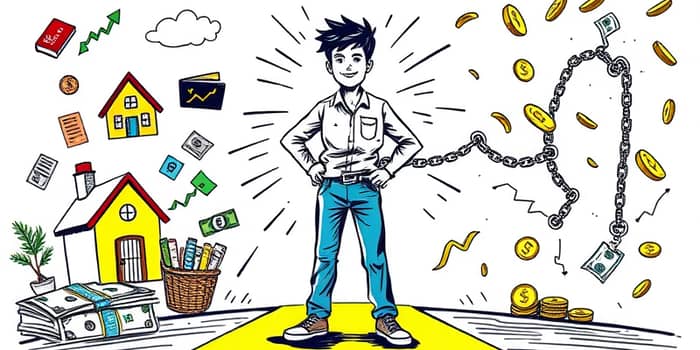Debt often carries a negative stigma, but it can be a powerful financial tool when used wisely. Whether you're buying a home, funding education, or swiping credit cards, the nature of debt determines its impact on your future. Understanding the distinction between good and bad debt is essential for making critical long-term financial decisions.
Consider two different paths: one individual borrows to attend college, leveraging that degree into a fulfilling career. Another swipes credit cards for luxury vacations and designer goods, only to watch interest charges spiral out of control. These scenarios illustrate how debt can either build a brighter future or become a crushing burden.
Defining Good and Bad Debt
Good debt refers to borrowing that enhances your net worth or generates income over time. It finances assets expected to appreciate or opportunities to increase earnings.
Bad debt, on the other hand, funds consumptive expenses or assets that depreciate rapidly, often carries onerous high-interest credit balances and little to no lasting value.
Good debt often comes with supporting documentation or financial planning, such as mortgage amortization schedules or student loan repayment plans. In contrast, bad debt is frequently impromptu and lacks a clear path to payoff, leaving borrowers vulnerable to financial stress.
Key Criteria to Differentiate Debt
Before taking on any liability, evaluate these five dimensions to see which side of the divide your debt will fall on.
- long-term net worth impact: Does the debt help build wealth or erode it?
- financing appreciating versus depreciating assets: Are you investing or consuming?
- interest rates and repayment terms: Are rates manageable or do they balloon over time?
- projected return on investment: Will the borrowed capital generate future income?
- payment manageability relative to your monthly income: Can you comfortably meet payment obligations?
Examples of Good Debt
Borrowing can be wise when it serves as an investment in your future. Each form of good debt has its own nuances, but they share the common trait of deploying borrowed capital for long-term gain.
- Mortgage on a primary residence: Historical home appreciation averages 3–4% annually, turning a $235,000 purchase into $485,000–$649,000 over 30 years.
- Student loans for high-ROI careers: Funding a professional degree may cost $100,000 but can lead to a substantial salary increase.
- Business loans: Supporting startup costs or expansion can boost earnings and enterprise value.
- Career-development financing: Certifications and technical training often yield immediate salary gains.
- Refinancing existing loans: Consolidating high-interest debt can lower payments and free up cash flow.
For instance, homeowners who consistently make extra principal payments can shave years off their mortgage and save tens of thousands in interest. Students who select programs with high job placement rates often see their loans as stepping stones to financial independence rather than burdens. When managed responsibly, these borrowing strategies employ increasing your future earnings while building equity.
Comparative Overview
Examples of Bad Debt
Bad debt primarily funds goods or services that lose value quickly or incur onerous interest charges.
High-interest credit cards can trap consumers in cycles of minimum payments, while payday loans and title loans charge APRs in excess of 300%. According to recent data, the average U.S. household carries over $6,000 in credit card debt, with average APRs exceeding 17%. Such obligations can balloon quickly, leaving little room for savings or investment. Car loans for luxury models or personal loans for vacations are classic examples of debt that does not build lasting value.
When Debt Falls Into a Grey Area
Not every borrowing decision is clear-cut. A car loan may be warranted if required for employment, but problematic if the vehicle is a non-essential luxury. Mortgages can become burdensome if housing costs far outpace income. The line between good and bad debt often rests on individual financial position and personal goals and the asset’s performance.
Tools like budgeting apps and debt calculators can help visualize how payments affect your cash flow over time, turning abstract obligations into manageable figures.
Impact on Credit and Financial Health
Well-structured debts, paid on schedule, can boost your credit score, lower future borrowing costs, and signal fiscal responsibility to lenders. On average, borrowers with primarily installment debt and low utilization rates maintain FICO scores above 700, while those maxing out credit cards often see scores drop below 650. Conversely, missed payments and high balances on bad debts can lead to collections, damage credit, and even bankruptcy, compromising your ability to borrow in the future.
How to Evaluate Your Debt
Regularly review your obligations with these questions in mind: Will this debt enhance your long-term financial position? What is the total cost including fees and interest? Are the repayment terms realistic based on your budget? Is the borrowed asset likely to appreciate or generate income?
Strategies to Avoid Bad Debt
- Borrow only for assets or opportunities with long-term benefits.
- Refinance high-cost obligations to lower interest rates.
- Prioritize paying down high-interest balances first.
- Maintain an emergency fund to reduce reliance on credit.
Consider adopting the debt snowball or avalanche method, automate payments to avoid late fees, and seek professional advice if consolidation or counseling can improve your terms.
Conclusion
Debt is a powerful tool that can pave the way to home ownership, education, and business growth, but it can just as easily lead to financial strain when misused. By distinguishing between good and bad forms of borrowing, assessing interest costs, and prioritizing manageable repayments, you can harness debt to build a strong financial foundation rather than undermine it.
With cautious planning and disciplined execution, your debt can transition from a burden into advanced strategic debt management techniques that set the stage for lasting prosperity.
Ultimately, recognizing the difference between obligations that build versus those that burden is the first step in forging a path to financial freedom. Let your informed choices today become the cornerstone of a prosperous tomorrow.
References
- https://www.fidelity.com/learning-center/smart-money/good-debt-vs-bad-debt
- https://www.equifax.com/personal/education/credit/report/articles/-/learn/understanding-credit-good-debt-vs-bad-debt/
- https://www.investopedia.com/articles/pf/12/good-debt-bad-debt.asp
- https://www.capitalone.com/learn-grow/money-management/good-debt-vs-bad-debt/
- https://www.schwab.com/learn/story/good-debt-vs-bad-debt-wellness-screening
- https://www.experian.com/blogs/ask-experian/good-debt-vs-bad-debt-whats-the-difference/
- https://www.achieve.com/learn/debt-basics/good-debt-bad-debt
- https://www.debt.org/advice/good-vs-bad/










